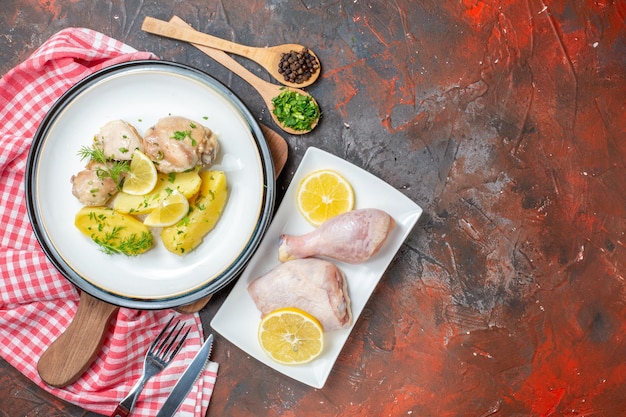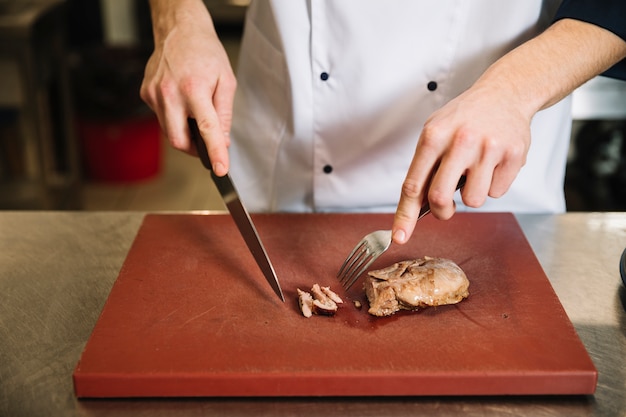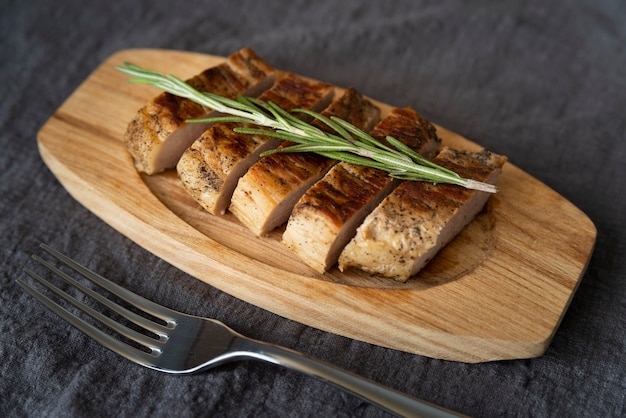(Part 1) Understanding Your Weapon of Choice: The Pork Tenderloin

Before we dive into the cooking process, let's talk about the star of the show, the pork tenderloin. It's a lean, long muscle that comes from the loin, just below the backbone. It's incredibly versatile, perfect for grilling, roasting, pan-frying, or even stuffing. The key to a great pork tenderloin, though, is understanding how to cook it properly to avoid that dreaded dry and tough texture.
What Makes it Tick: The Anatomy of a Pork Tenderloin
Think of it as a long, slender cylinder, usually about 1-1.5 pounds. It's tender, yes, but it can also be quite lean. This leanness can be a bit of a double-edged sword. On the one hand, it's healthy! On the other, it means it can dry out quickly if not handled carefully. It's important to remember that pork tenderloin is a relatively small muscle, and it doesn't have a lot of fat marbling. This means that it doesn't have a lot of natural moisture to protect it from drying out during cooking.
The Secret to Juicy Success: Moisture, Moisture, Moisture!
The single most important thing to remember with pork tenderloin is to keep it moist. That means cooking it to the right temperature, using the right technique, and ensuring it's not overcooked. We'll explore these in detail later on.
(Part 2) Preparation is Key: Setting the Stage for a Stellar Pork Tenderloin

Just like any good performance, a perfect pork tenderloin needs a bit of preparation. This is where we lay the groundwork for juicy, flavorful results.
Getting Started: Picking the Perfect Pork Tenderloin
First things first, you need a decent pork tenderloin. Look for one that's firm to the touch, with a nice, even color. Avoid any cuts that have a pale or grayish tint, as this could indicate poor quality. A good pork tenderloin should have a slightly pink hue and a firm, springy texture.
The Trimming Tango: Removing the Silver Skin
Now, you'll want to remove that pesky silver skin. It's a thin, tough membrane that can make the tenderloin tough to chew. It's easy enough to do - just grab a sharp knife and run it along the underside of the tenderloin, carefully peeling away the skin. You can also use a paper towel to help grip the skin as you peel it off.
Seasoning with Soul: Adding Flavor to the Party
Seasoning is where you get to really unleash your culinary creativity. A simple salt and pepper rub is always a classic choice, but you can really go wild with herbs, spices, and even a bit of citrus zest. I love experimenting with different flavour profiles, and a little bit of rosemary, garlic, and lemon zest really brings out the natural flavour of the pork. However, don't overdo it! You don't want to mask the natural flavor of the pork.
Adding a Touch of Magic: The Benefits of Brining
Brining is a technique that involves soaking meat in a salt-water solution, which helps to retain moisture and enhance flavor. It's a great option for pork tenderloin, especially if you're concerned about dryness. Simply combine salt, sugar, and water in a large bowl or container. Submerge your pork tenderloin in the brine and refrigerate for at least 4 hours, or up to overnight. Brining can really make a difference in the tenderness and juiciness of your pork tenderloin.
(Part 3) The Culinary Dance: Cooking Methods for a Perfectly tender pork Tenderloin

Now we're getting to the fun part – the actual cooking! There are a few popular methods, each with its own quirks and advantages. Choosing the right cooking method will depend on your preferences, the time you have, and the equipment you have available.
The Roasting Method: Slow and Steady Wins the Race
This is a classic approach, perfect for large gatherings. It's simple and straightforward. Just preheat your oven to 375 degrees Fahrenheit (190 degrees Celsius), season your tenderloin, and pop it into the oven for about 20-25 minutes, or until the internal temperature reaches 145 degrees Fahrenheit (63 degrees Celsius). Roasting in the oven is a reliable method that allows the tenderloin to cook evenly, resulting in a juicy and flavorful result.
The Pan-Frying Method: Quick and Easy for a Weeknight Meal
Pan-frying is a great option for a quick and easy meal. Simply heat some oil in a pan over medium-high heat, sear the tenderloin on all sides, then reduce the heat and cook for about 10-12 minutes, or until cooked through. Pan-frying can create a beautiful crust on the tenderloin, while still keeping the inside moist.
The Grilling Method: For That Smoky Outdoor Flavor
If you're lucky enough to have a grill, then grilling is a fantastic way to add a smoky flavour to your pork tenderloin. Pre-heat your grill to medium-high heat, then sear the tenderloin on each side for about 3-4 minutes. Then, reduce the heat to medium-low and continue cooking for about 10-12 minutes, or until cooked through. Grilling can be a bit more challenging, as it can be difficult to maintain an even temperature. However, the smoky flavor is well worth the effort.
The sous vide method: The Ultimate in Tenderness
Sous vide is a fancy term for cooking food in a water bath. It's a great way to ensure perfectly cooked meat, as it's practically impossible to overcook it. Simply season your tenderloin, vacuum-seal it in a bag, and immerse it in a water bath heated to 145 degrees Fahrenheit (63 degrees Celsius) for about 1-2 hours. After that, sear the tenderloin in a hot pan for a minute or two on each side to give it a nice crust. Sous vide is a great option for those who want to guarantee perfectly cooked pork tenderloin every time.
(Part 4) Monitoring the Situation: Checking the Temperature for Doneness
One of the most crucial steps in cooking any meat is ensuring it's cooked to the right temperature. This is especially true for pork tenderloin, as it can go from juicy to dry in a flash if overcooked.
The Temperature Tale: Using a meat thermometer for Accuracy
The best way to determine doneness is by using a meat thermometer. Insert it into the thickest part of the tenderloin, making sure it doesn't touch any bone. The ideal internal temperature for pork tenderloin is 145 degrees Fahrenheit (63 degrees Celsius).
The Resting Ritual: Letting the Tenderloin Relax
Once the tenderloin reaches the desired temperature, take it out of the oven, pan, or grill, and let it rest for 10-15 minutes before slicing. This allows the juices to redistribute throughout the meat, resulting in a more tender and flavorful end product.
(Part 5) Slicing and Dicing: Presenting Your Masterpiece
After all that hard work, you're ready to reap the rewards.
The Art of Slicing: Thin Slices for Maximum Flavor
When slicing your tenderloin, go for thin slices, about 1/2 inch thick. This will help ensure that the meat is evenly cooked and tender. I find that using a sharp knife makes all the difference. You can also use a carving fork to help hold the tenderloin in place as you slice it.
Serving Suggestions: Accompanying the Star of the Show
A perfectly cooked pork tenderloin is delicious on its own, but it really shines when paired with the right accompaniments. I love serving it with a simple side of mashed potatoes, roasted vegetables, or a fresh green salad. A creamy sauce, like a mushroom sauce or a white wine sauce, can also add a touch of elegance to your dish.
(Part 6) Beyond the Basics: Adding Extra Flair to Your Pork Tenderloin
Now that you've got the fundamentals down, let's explore some ways to elevate your pork tenderloin game.
Stuffing with Style: Enhancing Flavor with a Filling
Stuffing your pork tenderloin is a great way to add extra flavour and intrigue. Think of it as a flavour-bomb! You can use a classic sausage and herb stuffing, or get creative with combinations like apple and sage, or even a spinach and feta mixture. To stuff your tenderloin, make a small incision along the side, then gently spread open the tenderloin to create a pocket. Fill the pocket with your chosen stuffing and carefully close it up with toothpicks or kitchen twine.
The Glazing Game: Adding a Sweet and Savory Touch
A glaze can transform your pork tenderloin from good to glorious. Think of it as a final flourish! A simple honey-soy glaze is a classic choice, but you can also get adventurous with combinations like maple syrup and Dijon mustard, or even a balsamic vinegar glaze. The glaze can be applied during the last 15-20 minutes of cooking, or you can brush it on after the tenderloin has rested.
The Garnish Factor: Adding a Final Touch of Elegance
A sprinkle of fresh herbs, a drizzle of balsamic glaze, or a few slices of lemon can make your pork tenderloin look even more impressive. It's all about those little details! You can also add a sprig of rosemary or a few thyme sprigs to the top of the tenderloin before serving.
(Part 7) Mastering the Art of the Leftovers
Let's face it, sometimes we make more than we can eat. But don't fret! pork tenderloin leftovers are a delicious way to stretch your culinary efforts.
The Leftover Revival: Turning Leftovers into New Dishes
Leftover pork tenderloin can be incorporated into a variety of dishes, such as sandwiches, salads, or even pasta. You can slice it up and add it to a hearty soup or stew. I love to make a simple pork and potato salad with my leftover tenderloin. Simply combine the sliced tenderloin with diced potatoes, chopped celery, mayonnaise, mustard, and your favorite seasonings.
Storage Strategies: Keeping Your Pork Tenderloin Safe and Delicious
To ensure your leftovers stay safe and delicious, store them in an airtight container in the refrigerator for up to 3-4 days. You can also freeze them for up to 2-3 months. When freezing, wrap the tenderloin tightly in plastic wrap and then in aluminum foil. When ready to use, thaw it in the refrigerator overnight.
(Part 8) Troubleshooting Tips: Tackling Pork Tenderloin Challenges
Even the most experienced cooks can encounter a few bumps in the road. Here are some common pork tenderloin challenges and how to avoid them:
The Dryness Dilemma: Preventing a Tough and Unpalatable Tenderloin
The most common issue with pork tenderloin is dryness. To avoid this, ensure you don't overcook it. Use a meat thermometer to check the internal temperature, and let the tenderloin rest for 10-15 minutes after cooking to allow the juices to redistribute. Another way to prevent dryness is to cook the tenderloin in a moist environment, such as a slow cooker or a water bath.
The Overcooked Catastrophe: Signs of an Unforgiving Tenderloin
If your tenderloin is overcooked, it will be tough and dry. There's not much you can do to salvage it at this point, but you can try to make it more palatable by adding a sauce or gravy. The best way to avoid overcooking is to use a meat thermometer and cook the tenderloin to the correct internal temperature.
The cooking time Crisis: Adjusting for Different Sizes and Weights
The cooking time for pork tenderloin will vary depending on the size and weight of the cut. A good rule of thumb is to cook for about 15-20 minutes per pound. Use a meat thermometer to check the internal temperature to ensure it's cooked through.
FAQs: Your Burning Questions Answered
You've got questions, I've got answers. Let's tackle some common inquiries about cooking the perfect pork tenderloin.
1. Can I Marinate Pork Tenderloin?
Absolutely! Marinating your pork tenderloin can add incredible flavour and tenderness. You can use a simple marinade of oil, vinegar, and herbs, or get creative with more complex flavour profiles. Just make sure to marinate for at least 30 minutes, or even better, overnight, for maximum flavour infusion. Marinating helps to tenderize the meat and add moisture, which can help to prevent dryness.
2. Can I Cook Pork Tenderloin with the Skin On?
While you can cook it with the skin on, it's not recommended. The skin is tough and chewy and won't break down during cooking. It's best to remove the skin before cooking to ensure a tender and flavorful final product. The skin can also make it difficult to get a good sear on the tenderloin.
3. How Do I Know When My Pork Tenderloin is Done?
The best way to determine doneness is by using a meat thermometer. The ideal internal temperature for pork tenderloin is 145 degrees Fahrenheit (63 degrees Celsius). You can also check the color of the meat - it should be slightly pink in the center, not raw or red.
4. Can I Freeze Pork Tenderloin?
Yes, you can! Just wrap it tightly in plastic wrap or aluminum foil and store it in the freezer for up to 2-3 months. When ready to use, thaw it in the refrigerator overnight. Freezing can sometimes affect the texture of the tenderloin, but it's a great way to save leftovers.
5. What Happens If My Pork Tenderloin is Overcooked?
If your pork tenderloin is overcooked, it will be tough and dry. There's not much you can do to salvage it at this point, but you can try to make it more palatable by adding a sauce or gravy. Next time, make sure you don't overcook it by using a meat thermometer to check the internal temperature.
There you have it, folks. A comprehensive guide to cooking a pork tenderloin that'll leave you feeling like a culinary wizard. Go forth, experiment, and impress your loved ones with a masterpiece that's both delicious and easy to achieve. Happy cooking!
Everyone is watching

How to Cook Frozen Lobster Tails Perfectly: A Step-by-Step Guide
RecipesLobster. Just the word conjures up images of lavish meals, special occasions, and a taste of luxury. But let's...

Pigs in a Blanket Cooking Time: How Long to Bake for Perfect Results
RecipesAh, pigs in a blanket. Just the name conjures up images of those delightful little parcels of crispy pastry en...

Pork Fillet Cooking Time: How Long to Cook It Perfectly
RecipesPork fillet, or tenderloin as it's sometimes called, is a real favourite in our house. It's so versatile, and...

The Ultimate Guide to Cooking Delicious Frankfurters
RecipesLet's face it, we all love a good frankfurter. It's a classic, simple, and always satisfying. But let's be rea...

Wolf Meat Recipes: A Guide to Cooking Wild Game
RecipesLet's be honest, you don't see wolf meat at your local butcher shop every day. It's a bit of a wild card, but ...
